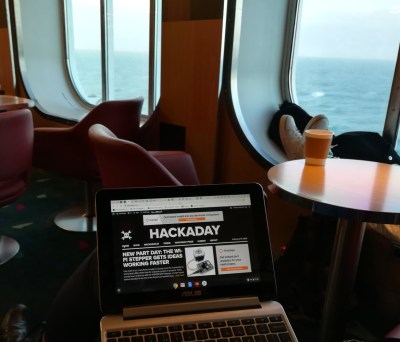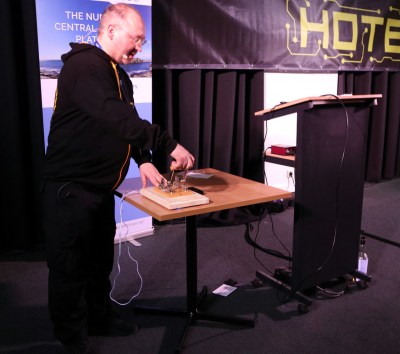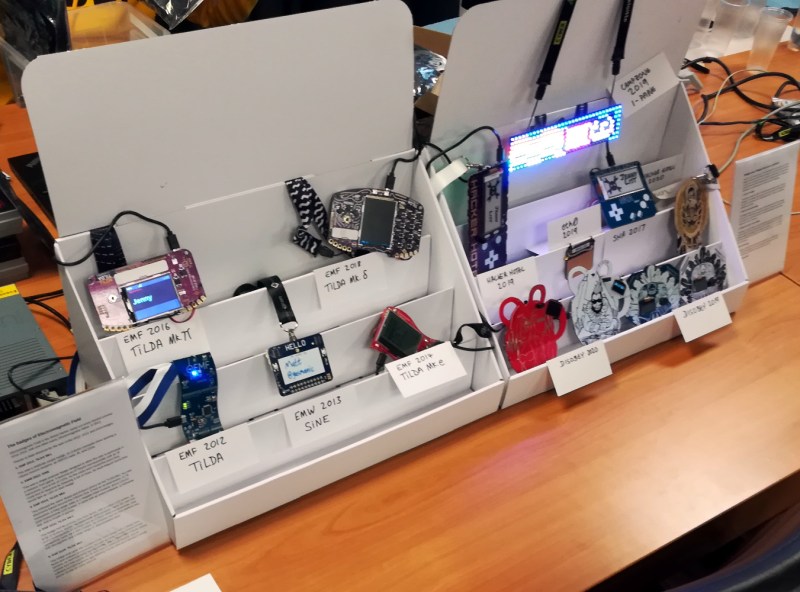The North Sea in a winter storm is a spectacular sight, one of foam-crested waves and squalls driven on the gale. It’s not a place to spend a lot of time if you are a land-lubber, so to cross it twice in a few weeks must mean there is something very much worth seeing on its other side.

But one of the best antidotes to February weather in the European hacker community was Hacker Hotel 2020. Around 350 people came from all the countries of the northwest of the continent to the comfort and hospitality of the Westcord Hotel de Veluwe in the eastern Netherlands, to experience a hacker camp with all the convenience and luxury of a resort hotel rather than a muddy field.
Three days in this environment results in a camp that’s just a bit special, and one that’s very much worth a visit if your range extends this far.
An Upscale Hotel Gets The Hacker Treatment

Our small party of Brits arrived a day early, on a damp Thursday morning ready to lend a hand with the set-up. Slowly an upscale business conference centre was transformed into a hacker camp venue, with conference rooms turned into lecture halls, lighting and video equipment in place and 3-phase power cables snaking along the skirting boards. A large hardware hacking area was set up in one wing of the building, then the EventInfra people came in and laid out a hacker-camp-grade wireless and wired network that delivered connectivity everywhere. The contrast between the two worlds is significant, but together they make for a unique experience.
One by one, hackers arrived from all points of the compass, bearing crates of the usual cool stuff. An amateur TV satellite earth station, a brace of oversized delta 3D printers, a coin-pushing game that’s familiar from other camps. And smaller projects; little roving robots, indoor-sized multirotors, and several crates of outdated Chinese photo-frames that it’s said can be hacked to run a Linux distro.
This is the lifeblood of a hacker camp, but of course the signature piece of hardware for any hacker camp is its badge. In this Hacker Hotel 2020 didn’t disappoint, with a beautifully designed Ancient Egyptian-themed badge that concealed an array of puzzles across multiple levels. We’ll cover the badge in detail in a separate piece, but suffice to say that it is something of a tour de force. For now let’s jump into all of people and activities on offer at the con.
Plenty Of Talks To Occupy Your Brain

This event is one with a bit more software and infosec than hardware, but there was still plenty to amuse the hardware enthusiast and plenty of interesting stuff from the rest of the programme. The schedule kicked off with organiser Dimitri Modderman’s welcome, then proceeded straight into a (sadly not recorded) talk from Walter Belgers on UNIX hacking by students in the late 1980s and early 1990s. Nostalgic for me, who at the same time could often be found wrestling with text-mode SPICE or pulling down Amiga shareware in a similar lab at another European university.
The talks had more of an emphasis on infosec and software than hardware, even the promising-looking open-source SOC talk from [Roel van der Valk] was about Security Operations Centres rather than Systems On Chip. Worth seeking out are [Sake Blok] on using Wireshark, [David], on the coffee roasting process and creating a coffee roasting product for Kickstarter, and perennial locksport speaker [Jos Weyers], on attacking master key systems.
An unexpected talk of interest came from [Anco Scholte ter Horst], on the establishment of the Dutch ISP Freedom Internet. While it has a lot specific to the Netherlands and the history of their first ISP XS4ALL, it was interesting to a non-Dutch person because setting up an ISP is something that happens vanishingly rarely in 2020.
Plenty Of Hacks To Please Your Eye
Upstairs in the hardware hacking area was the usual array of projects, and people clustered for hours round their laptops solving the badge puzzles. There were a few large exhibits, and some stand-out projects. On entry you might have heard some guitar music. [XDr4g0nX]’s bass guitar is 3D printed, and we’ve covered the tale of its construction elsewhere.
[Yvo de Haas] had brought along a tentacle-like mechanical robot arm with a very clever mechanism of interlinking segments coupled by gears, all controlled by a set of cables driven by two windlasses. The mechanism was under compression while the cables were under tension, making it a very stable structure indeed. Control was through a joystick and an Arduino driving the windlasses. I have a feeling that this is a project of which we will see more in the future, as he has plans to extend it beyond this prototype into more comprehensive robot arm functionality.
Meanwhile on another table was [Boekenwuurm], with two particularly eye-catching pieces of work. The first was an inflatable textile project that’s been on the go for a while. I mentioned that I’d seen an earlier set of experiments at the eth0 weekend camp last year, here she was taking that to the next level. There seems to be a fascination among sections of the European hacker community with the IKEA Blahåj stuffed shark, and in homage as her prototype she’d made a very impressive inflatable shark supplied with air from an electric leaf blower. Then she had also brought along an addressable LED cube cast within a clear resin cube which caught the attention of all passers-by. It sat on a pedestal containing its electronics, and was possessed of an almost-otherworldly glow. We’ve seen it all when it comes to addressable LEDs, and yet this one caught our attention.
Beyond that there was a collection of retrocomputers from [Benadski], and an amateur radio station with a special interest in TV. Sadly I’m told they didn’t manage the satellite contact they were hoping for, but they had plenty of other activity aside from their HF WSPR beacon.

Finally there was a project of mine with a little help from my friends across the European electronic badge community. I’ve spoken and written in more than one place in the past about how the astonishing creativity of the BadgeLife scene is an artistic movement coming entirely from within our community, and that it should be identified and established as such. To that end I’ve been working on the beginnings of a community-owned traveling museum with the aim of exhibiting at European hacker camps. In this I’m not alone, on the other side of the Atlantic [Marie-Lynn Richard] has been working on a similar project for the benefit of North Americans. Hacker Hotel 2020 saw the first proof-of-concept for our European exhibition, just two exhibits this time showing the progression of badges from both British and Dutch events. Watch this space for our future outings.
All good things come to an end, and with our ferry booked the following day we were able to help with the teardown. The hotel emerged from amid the wires and screens, and we are indebted to the staff for tolerating our eccentricities and making us very welcome. It’s interesting now to take a moment to reflect on what makes this camp different from some of the others we attend.
Aside from something cheerful in the damp and chilly depths of a Northern European winter, this camp is a little different because of the comfort of its venue. Thus it attracts a slightly more diverse crowd of people to whom the idea of roughing it in a dusty field is a little less attractive. It’s limited to somewhere in the region of 350 people by the size of the complex so it’s possible to get to know most of the attendees, and though a hotel room can make it a little more expensive than some camps there remains the budget option of sharing one of the many bungalows on the site. I look at it and can’t help thinking that this off-season formula of a comfortable venue and a small-to-medium sized hacker camp could work elsewhere too, I hope we might see more in future.
So back on the ferry we went, for a slightly bumpy but otherwise comfortable crossing to Harwich. This camp is a destination worth making the journey for next year!























We were happy to see everyone on the ground at HACKER HOTEL again this year! We are glad everyone enjoyed the CYBER SCARAB SAO we were giving away~ We are planning to do a second run for everyone that could not get one.
See you all next year!
https://tilde.industries/content/images/2020/02/IMG_20200214_182439-1.jpg
Learn more about it here: https://tilde.industries/cyber-scarab/
Braving the North Sea? Don’t you get to use the Hackaday private jet? Or is it in the hangar again because Mike won’t accept that having a deflector array does nothing but halve the fuel mileage at sub orbital speeds?
Hackaday jet has been much harder to fly this year, ever since Kristina discovered that ear switch and modified the flight controls to be completely tensor tympani muscle actuated.
Well at least that means you quit driving up the price of Force Trainers on eBay.
It’s all eco, innit. Surface travel FTW!
Jenny, what brand of obsolete Chinese picture frames are these? The Ceiva ones already do run Linux inside. And there’s an excellent website up that continues an MIT grad student’s adventure in getting his working again. The backlight quit on it as it happens.
The Jos Weyer talk link actually goes to the ISP talk.
Thanks Jenny for your awesome write up, it’s always a pleasure having you over and reading your article afterwards. Also it was cool to see so many people from abroad. UK, Germany,Luxemburg, France and even Albania this year. 350 seems to be the max, but we will be back next year at this lovely venue with it’s 97 rooms and 35 bungalows ;-)
Parrot. And there’s quite a lot of hacking info on them to be had.